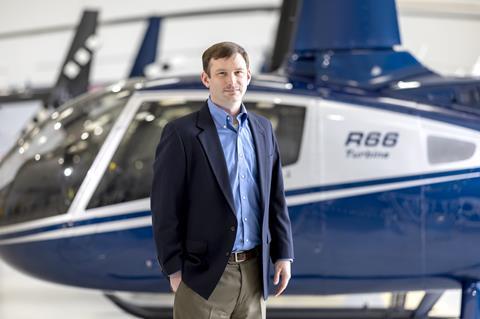Light rotorcraft maker Robinson Helicopter and biotechnology firm United Therapeutics recently ground tested an R44 modified with hydrogen fuel cells, and the companies say test flights are imminent.
The hydrogen-equipped R44 is to make its first flight at United Therapeutics’ test facility near Montreal, though the partners do not disclose a target date for the sortie.
Executives from both companies tell FlightGlobal that, under an agreement signed on 14 August, they are poised to accelerate development of hydrogen-powered helicopters – including a hydrogen-powered, “pilot optional” R66. United Therapeutics intends to use the aircraft to deliver transplantable organs throughout North America.
The R44 is piston-engined while the R66 has a turboshaft.
“Phase one is basically targeting strictly the hydrogen powerplant system,” says Mikael Cardinal, vice-president of programme management at Unither Bioelectronic, a United Therapeutics subsidiary working to use novel aircraft, including electric vertical take-off and landing (eVTOLs) types, to transport organs.
”With the optionally piloted or more-autonomous helicopter, development is happening on a parallel track. Eventually, we plan to merge those two capabilities – zero-emissions flight and some level of autonomy,” Cardinal told FlightGlobal on 26 August.

Robinson is lending its experience with engineering and certification, building off several years of Unither’s work. In 2022, the latter company successfully flew a battery electric variant of a R44 helicopter developed in collaboration with Tier 1 Engineering. Unither delivered transplantable lungs with a drone the year prior.
Now, Unither is working directly with Robinson on a strategy to retrofit the larger R66 and pursue certification with Transport Canada and the Federal Aviation Administration.
“We are honoured to be working with one of the world’s largest helicopter manufacturers as we continue to extend our track record of saving hundreds of lives through aviation-delivered transplanted lungs,” Martine Rothblatt, chief executive of United Therapeutics, said on 14 August.
Cardinal is charged with overseeing the company’s collaboration with Robinson and Unither’s in-house development of the hydrogen fuel cell system currently being tested on the R44 test article.
“We are very excited about the Robinson Helicopter agreement targeting hydrogen,” Cardinal says. “Via that collaboration, we will be able to push hard on all those certification questions, given the Robinson legacy of certifying retail vehicles.”
LONG-TERM AMBITIONS
Robinson was supportive of Unither’s hydrogen helicopter project but not directly involved prior to this year, David Smith, Robinson’s chief executive, tells FlightGlobal.
The trailblazing light helicopter maker has increasingly embraced next-generation propulsion and flight-control technologies since Smith – following a nearly 20-year career with Textron Aviation – succeeded Kurt Robinson as CEO in February. He is only the third person to lead the company since it was founded by the late Frank Robinson in 1973.
Smith says he is leading Robinson into new territory with the blessing of his predecessor. ”We’ve got internal resources that are focused on the broad topic of electrification. Everything from batteries, motors, motor-control units [and] the software development needed for control, batteries and motors certification.”
“Now, with United Therapeutics, we’re getting involved in hydrogen and fuel cells and all the challenges those can present from the certification side,” Smith adds.
The R66 platform lends itself to being equipped with hydrogen propulsion, Smith says. The type has an “enormous baggage bay” that could be adapted for containing liquid hydrogen, in addition to the aircraft’s fuel bladders. “You have this whole section that’s directly under the mast, and could be a pretty good place for primary hydrogen containment.”
An engineer by trade, he appreciates the technical heavy-lifting already completed by Robinson’s new partner.
“United Therapeutics got into both flight-testing and continued flight development,” Smith says. “A lot of really important work was done – they manufactured battery cells and battery packs out of off-the-shelf cells. They integrated several motor variants and did a lot of software development of motor and battery controls.”

As a sceptic of the electric-vertical take-off and landing (eVTOL) segment, Smith asserts a fleet of modified Robinson helicopters represents a more-economical route to decarbonisation.
“I think we are going to offer a really compelling value,” he says. “Our stuff will cost a third or quarter of what market leaders in the eVTOL industry [propose], and I think it will be very hard to justify a product four times more expensive.”
Smith also suggests that maintaining eVTOLs will be a greater challenge than keeping Robinson’s simple two-bladed helicopters in the air.
“When you consider the number of individual blades, the number of individual motors, speed controllers, power feeders – all the stuff that is required for a high-voltage eVTOL with 12-16 motor stacks – that’s a lot of complexity to manage and it will be difficult to keep those airworthy.”
Cardinal says that choosing to modify an existing aircraft – rather than betting on a clean-sheet design – was a decision driven by pragmatism on the part of United Therapeutics.
“Certification is difficult, so tapping into a well-known airframe that is already type certified, and adding that little ‘s’ for supplemental type certification, is a good way to de-risk the certification challenges for new technology,” he says.
The societal benefits of transporting lifesaving organs could encourage aviation regulators to view the project more favourably, Cardinal suggests. United Therapeutics also plans fly fixed routes, rather than a “complex, on-demand mobility flight operation” – which could help minimise the complexity of certification.
The organ-delivery system envisioned by United Therapeutics requires an aircraft range of about 250nm (463km), with a first phase of the rollout focusing on the East Coast of Canada and the USA. Cardinal expects fuel-cell technology to get “lighter and lighter” as it matures, potentially enabling greater range.
Neither company specifies when they plan for the hydrogen-equipped R66 to clear certification and enter service. But work is already underway, Cardinal says: “We believe it can be achieved with the Robinson airframe.”































